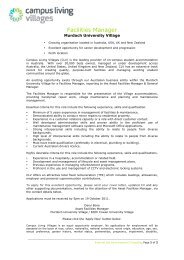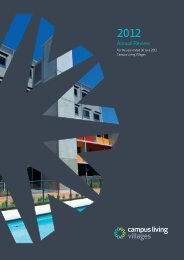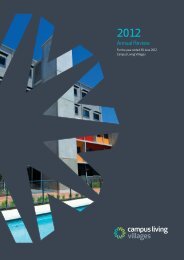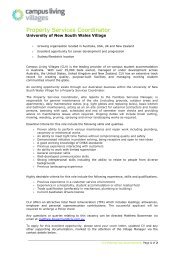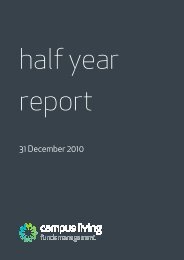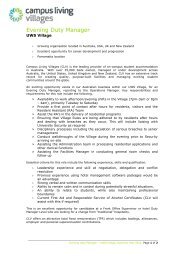Annual Report - Campus Living Villages
Annual Report - Campus Living Villages
Annual Report - Campus Living Villages
Create successful ePaper yourself
Turn your PDF publications into a flip-book with our unique Google optimized e-Paper software.
1 2 0 <strong>Campus</strong> <strong>Living</strong> <strong>Villages</strong> <strong>Annual</strong> <strong>Report</strong> 09/10<br />
<strong>Campus</strong> <strong>Living</strong> Overseas Trust<br />
NOTES TO THE CONSOLIDATED FINANCIAL STATEMENTS<br />
FOR THE YEAR ENDED 30 JUNE 2010<br />
A$’000<br />
CLOT<br />
The fair value of financial instruments traded in active markets<br />
(such as publicly traded derivatives, and trading and available<br />
for- sale securities) is based on quoted market prices at the<br />
balance sheet date. The quoted market price used for financial<br />
assets held by the consolidated entity is the current bid price.<br />
The fair value of financial instruments that are not traded in<br />
an active market (for example, over-the-counter derivatives)<br />
is determined using valuation techniques. The consolidated<br />
entity uses a variety of methods and makes assumptions<br />
that are based on market conditions existing at each balance<br />
date. Quoted market prices or dealer quotes for similar<br />
instruments are used for long-term debt instruments held.<br />
Other techniques, such as estimated discounted cash flows,<br />
are used to determine fair value for the remaining financial<br />
instruments. The fair value of interest rate swaps is calculated<br />
as the present value of the estimated future cash flows. The<br />
fair value of forward exchange contracts is determined using<br />
forward exchange market rates at the balance sheet date.<br />
The carrying value less impairment provision of trade<br />
receivables and payables are assumed to approximate their<br />
fair values due to their short-term nature. The fair value of<br />
financial liabilities for disclosure purposes is estimated by<br />
discounting the future contractual cash flows at the current<br />
market interest rate that is available to the consolidated<br />
entity for similar financial instruments.<br />
n) Property, plant and equipment<br />
Property, plant and equipment is stated at historical cost<br />
less depreciation. Historical cost includes expenditure<br />
that is directly attributable to the acquisition of the items.<br />
Subsequent costs are included in the asset’s carrying amount<br />
or recognised as a separate asset, as appropriate, only when<br />
it is probable that future economic benefits associated with<br />
the item will flow to the consolidated entity and the cost<br />
of the item can be measured reliably. The carrying amount<br />
of any replaced part is derecognised. All other repairs and<br />
maintenance are charged to the Statement of Comprehensive<br />
Income during the reporting period in which they are incurred.<br />
Land is not depreciated. Depreciation on other assets is<br />
calculated using the straight-line method to allocate their cost<br />
or revalued amounts, net of their residual values, over their<br />
estimated useful lives, as follows:<br />
Buildings<br />
Vehicles<br />
Furniture, fittings and equipment<br />
Leasehold improvements<br />
Leased plant and equipment<br />
25-40 years<br />
3-5 years<br />
3-8 years<br />
25-35 years<br />
10-15 years<br />
Gains and losses on disposals are determined by comparing<br />
proceeds with carrying amount. These are included in the<br />
statement of comprehensive income. When revalued assets<br />
are sold, amounts included in other reserves in respect of<br />
those assets are transferred to retained earnings.<br />
o) Intangibles<br />
Goodwill<br />
Goodwill represents the excess of the cost of an acquisition<br />
over the fair value of the consolidated entity’s share of the<br />
net identifiable assets of the acquired subsidiary/associate<br />
at the date of acquisition. Goodwill is not amortised. Instead,<br />
goodwill is tested for impairment annually, or more frequently<br />
if events or changes in circumstances indicate that it might be<br />
impaired, and is carried at cost less accumulated impairment<br />
losses. Gains and losses on the disposal of an entity include<br />
the carrying amount of goodwill relating to the entity sold.<br />
Goodwill is allocated to cash-generating units for the purpose<br />
of impairment testing. Each of those cash-generating units<br />
represents the consolidated entity’s investment in each<br />
country of operation by each primary reporting segment.<br />
Management contracts<br />
Management contracts acquired as part of a business<br />
combination are recognised separately from goodwill. The<br />
management contracts are carried at their fair value at<br />
the date of acquisition less accumulated amortisation and<br />
impairment losses. Amortisation of management contracts is<br />
calculated based on the timing of projected cash flows of the<br />
contracts over their estimated useful lives, which currently<br />
vary from 20 to 30 years.<br />
p) Trade and other payables<br />
These amounts represent liabilities for goods and services<br />
provided to the consolidated entity prior to the end of<br />
financial year which are unpaid. The amounts are unsecured<br />
and are usually paid within 30 days of recognition. Deferred<br />
revenue represents income received in advance from students<br />
at the beginning of the semester and is released to revenue<br />
when the recognition criteria have been met.<br />
q) Borrowings and borrowing costs<br />
Borrowings are initially recognised at fair value, net of<br />
transaction costs incurred. Borrowings are subsequently<br />
measured at amortised cost. Any difference between the<br />
proceeds (net of transaction costs) and the redemption<br />
amount is recognised in the statement of comprehensive<br />
income over the period of the borrowings using the effective<br />
interest method.<br />
The assets’ residual values and useful lives are reviewed,<br />
and adjusted if appropriate, at each balance sheet date. An<br />
asset’s carrying amount is written down immediately to its<br />
recoverable amount if the asset’s carrying amount is greater<br />
than its estimated recoverable amount.



